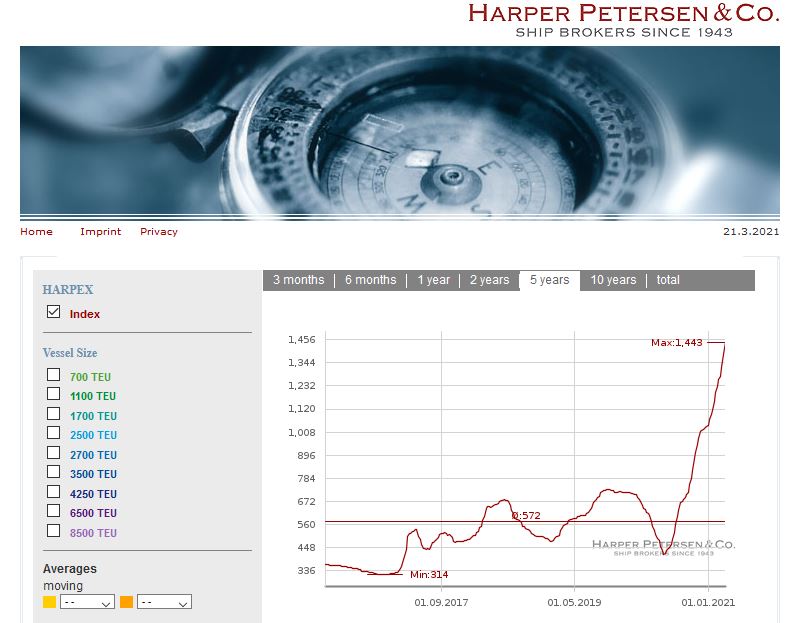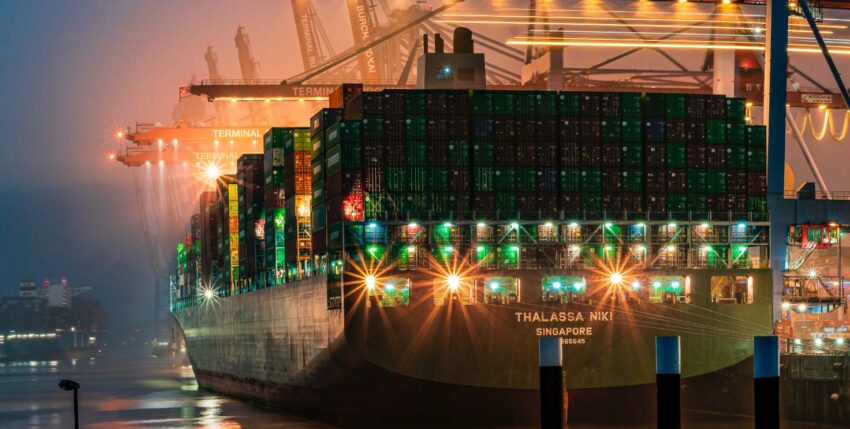The importance of containers in international trade
They are the workhorses of the international economy - whether on the high seas, on land or in the air, the countless Containerhow Sea containertank containers, refrigerated containers and other types of containers that are in circulation every day. Robust, with an impressive size, a considerable volume and perfectly stackable, these transport containers in various sizes provide reliable transport and are essential for global trade. From the food trade and fruit trade to the book trade and other specialist retail sectors through to the entire spectrum of online trade, retail and wholesale - there is hardly a sector that does not rely on the smooth running of transport around the globe. In July 2013, we here in the blog a contribution about the StandardContainer, the ISO container in use since 1956, as a silent hero of international trade:
8 feet wide, 8 feet high and 20 feet long - these are the basic dimensions of the steel transport container as we know it when travelling by rail, road or sea loaded with all kinds of things. About 17 million Container are in circulation worldwide, most of them in the TEU 20 (Twenty-foot Equivalent Unit) or TEU 40 (Forty-foot Equivalent Unit, 40 feet long) variation. The introduction of container freight was not just a stroke of genius to optimise logistics chains, but a global economic revolution, the significance of which is only now becoming clear thanks to current research - one could call the Container can also be described as a silent hero of the 20th century.
The first transports in standardised wooden containers for switching between road and rail took place in Great Britain as early as the 19th century, but goods and merchandise were transported by sea as general cargo until the second half of the 20th century. This meant that the goods were stowed in the bellies of the ships as they fitted. Loading and unloading ships was correspondingly laborious and time-consuming, so it was not unusual for ships to spend more time in harbour than at sea.
The modern industrial container was not invented until after the Second World War in 1956 by Malcom P. McLean, an American lorry freight forwarder. McLean calculated that loading a ship with one tonne of freight in the Container cost only $0.16, compared to $5.83 for the same tonne as general cargo. The Container should be suitable for loading directly from lorry or rail onto the ship and back. This enables mass transport and mass handling as well as the loading and unloading of ships in record time today. From 1965, the container system was standardised and used in global trade.
Competition for the ISO container: the high cube container
In the meantime, significantly more Container of all kinds on the world's oceans; The world already spoke of 38 million euros in 2018 Containers in circulation. These are no longer just ISO containers standardised in height, width and length according to the ISO standard. High cube containers are now also widely used Container. The high cube container differs from the ISO container primarily in terms of size and dimensions. This is because the term high cube does not refer exclusively to the height, but rather to the number of cubic metres, i.e. the volume. Its special dimensions, large volume and wide range of possible uses, for example as a high cube sea container (also known as a HC sea container), mean that the high cube is increasingly competing with the ISO container. The reason? More Euro pallets and more goods simply fit into this high cube container, which is more spacious in width, length and height than the smaller ISO container. And that plays an important role in a business where competition is fierce and profit margins are small.
Freight containers as an economic indicator
Whether ISO or High Cube Container - Thanks to its importance for global trade, it is suitable as an economic indicator or, like the canary in the coal mine, as an economic early warning system. HARPEX, which has been published by shipbroker Harper Petersen & Co in Hamburg since 2004, shows the global price trend for container ships on the charter market.

As can be seen from the development of the index, the initial pandemic-induced dip was followed by a rapid and sustained price increase, which points to a shortage of globally available shipping and container space. Imagine the quantities of office equipment for the home office, the exercise bike for home sports and all the other online purchases that were shipped across the Pacific to the American market alone. This has led to the current phenomenon that the Sea container are literally piling up on the US West Coast and becoming scarce in Asia. The shortage is exacerbated by the fact that Sea container with medical merchandise such as protective masks were shipped to certain regions of South America and Africa, but were not collected there due to a lack of export opportunities. Instead of the goods being traded and Container back into circulation, they are now standing around unused. The current situation leaves even industry experts speechless. We read in the article "Chaos Strikes Global Shipping" from the New York Times:
"I've never seen anything like this," said Lars Mikael Jensen, head of Global Ocean Network at A.P. Moller-Maersk, the world's largest shipping company. "All the links in the supply chain are stretched. The ships, the trucks, the warehouses."
Economies around the globe are absorbing the ripple effects of the disruption on the seas. Higher costs for transporting American grain and soybeans across the Pacific threaten to increase food prices in Asia.
Empty containers are piled up at ports in Australia and New Zealand; containers are scarce at India's port of Kolkata, forcing makers of electronics parts to truck their wares more than 1,000 miles west to the port of Mumbai, where the supply is better.
While the ongoing impact of the pandemic on the global economy is certainly an exceptional situation, it will be exciting to see how the global market, trade and transport will change. Two major free trade agreements have recently been concluded, the full impact of which on trade has yet to unfold:
- 2019 African Continental Free Trade Area,
- 2020 Regional Comprehensive Economic Partnership (largest free trade zone in the world between the ten ASEAN member states and five other countries in the Asia-Pacific region)
Light and dark sides of container transport and trade
The dark side of global trade can also be seen in the Container can be expressed in figures, at least as an estimate. In the Issue 3-2021 of the marineforum we read in the article "The downside of world trade":
Ships are becoming ever more gigantic, the cargoes ever larger. Competition is fierce and profit margins are small. Precarious jobs, dubious loading practices, terrorism, smuggling and neglected environmental protection are the downside of prospering world trade. [...] Every day there are roughly five to six million Container at sea. It is known that thousands of them regularly go overboard every year. The World Shipping Council (WSC) claimed ten years ago that there were fewer than a thousand per year.
The number of people who fall overboard during transport each year ISO container, High Cube Container and co. is likely to be significantly higher - the WSC only reports the results of a survey of its members over a period of three years. Environmental organisations estimate that around 20,000 shipping containers are lost each year during transport on the high seas; the actual figure is likely to be somewhere in between. In the largest loss of sea containers to date, over 4,200 of these containers, which are enormous in size and volume, were lost in 2013 due to the accident involving the container ship MOL Comfort in the Arabian Sea. Container lost. The remarkable thing is that we don't even notice it: The shrinkage during transport is already priced in on the shelves (availability) and at the checkout (price).











One Response
I need a container delivery for my company. They are also absolutely essential for my global trade. It's good to know that there are high cube containers that are more spacious. I will take a closer look at this so that I can possibly transport more Euro pallets with goods. I found more information here: https://bohnen-kies.de/bonn